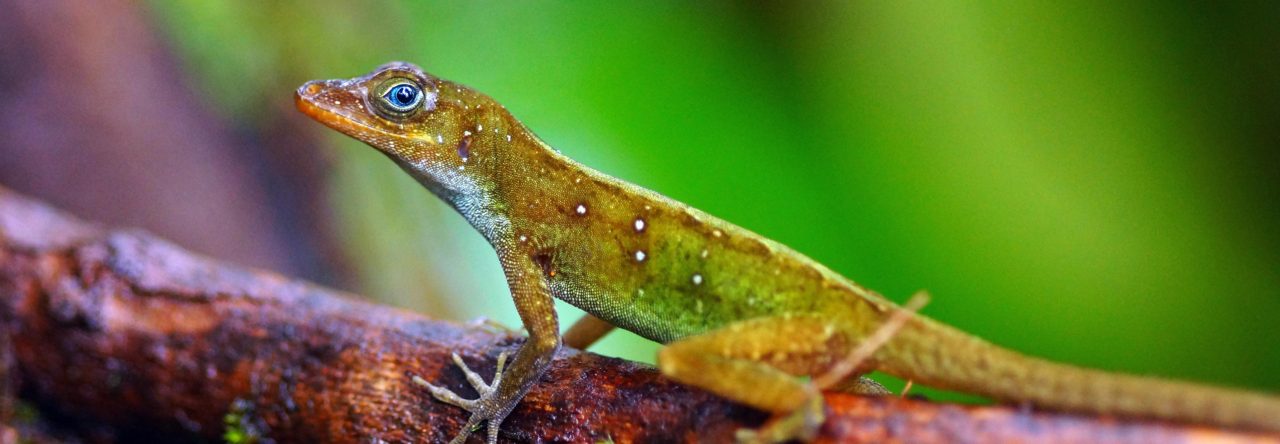Greetings, Anole Annals readers, from lovely Charleston. It may not be balmy here, but it’s warmer than my usual habitat of Cambridge, Massachusetts, which is currently experiencing an “Arctic front,” which is fancy speak for blistering cold wind. For those of you who couldn’t be here, this morning held some great Anolis talks at SICB, and I was able to attend three. The first was by Maureen Stimola, a senior undergraduate student at Columbia University who did her senior thesis with me in the Dominican Republic this past summer. Maureen’s research project addressed how thermal tolerance (CTmin and CTmax) changes with elevation in the cybotoids (A. cybotes and related trunk-grounds) from the Dominican Republic.
She was able to measure CTmin and CTmin in seven cybotoid species. Maureen found that CTmin decreases with elevation, both within A. cybotes and among cybotoid species, a pattern that holds true when phylogeny is taken into account. CTmax, however, does not change with elevation. Some behavioral measures associated with heat tolerance (panting threshold and evaporative voluntary maximum) did not change with elevation.
Next I went to a talk by J. Edwards from LSU on staged interactions between A. carolinensis and A. sagrei. In these trials, she measured both intra- and interspecific aggressive encounters, although intraspecific encounters were far more common. She used a modeling approach to understand what factors predict victory in staged fights. She found that medium-sized A. sagrei with large dewlaps and strong bite forces were the best competitors. Meanwhile, large A. carolinensis males with large dewlaps and the strongest bite forces were most victorious. Interesting, there is some evidence from the model that small A. carolinensis with weak bites are also good competitors. She suggested that running might be an effective strategy for “lightweight” A. carolinensis.
Finally, I attended a talk by Thom Sanger on the evolution of sexual shape dimorphism (SSD) in Caribbean ecomorphs. Interestingly, the magnitude of SSD does not vary with ecomorph. Thom showed that shape dimorphism evolves independently from size dimorphism, and so shape differences are not simply an effect of differences in size. He found that in grass-bush and trunk-crown anoles, females tend to have shorter faces while in trunk-ground anoles females tend to have smaller adductor chambers. He also identified two very interesting cases of extreme SSD in the hendersoni series of grass-bush anoles and the carolinensis series of trunk-crowns in which the difference between sexes exceeds 1.5 times the standard deviation. This extreme dimorphism may actually be due to allometric growth differences between the sexes, which is atypical among other anoles.
Then Thom talked a little about the molecular mechanisms underpinning SSD in anoles. He found that much of the SSD is driven by variation in the nasal process. Thom thought that differences in gene expression of hormone receptors might provide some clues as to what’s going on, but did not find any sex differences in expression. He did find, however, an upregulation of signaling molecules, including Bmp4, in females rather than males, which is a surprising result. Thom concludes that the relationship between hormones and morphology is likely much more complex than originally thought.
That’s all for now here in North Charleston. I’m looking forward to seeing what the rest of the conference has in store!
- SICB 2018: Revisiting the Fitch-Hillis Hypothesis in Mexican Anoles - January 8, 2018
- Evolution 2017: Urban Anoles Sprint Faster on Smooth Substrates - June 26, 2017
- SICB 2017: New Insights into Pre- and Postcopulatory Selection in Anoles - January 10, 2017


Maureen Stimola
I saw two more anole talks today! Bryan Falk from the American Museum of Natural History presented his research on parasite phylogeography and Anolis distribution in Puerto Rico, and Elizabeth Hutchins from Arizona State University discussed genome sequencing and musculature in A. carolinensis and A. apletophallus. Props!
Martha Munoz
You should write summaries about them for the Anole Annals!
Maureen Stimola
Hm. Maybe an activity for the 14 hour journey back to New York!
Yoel Stuart
What did J. Edwards have to say about the interactions between A. carolinensis and A. sagrei?
Martha Munoz
The talk was held in a room separate from the other ballrooms and, unfortunately, I only was able to catch the second half. You should ask Jessica about it: http://www.sicb.org/meetings/2012/schedule/abstractdetails.php?id=462